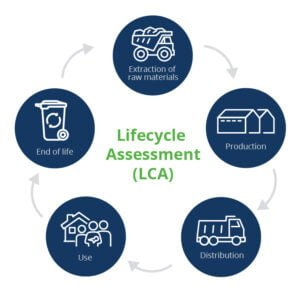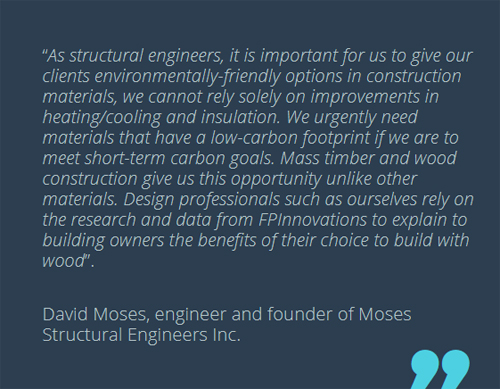To achieve the goals of Canada’s climate change plan and get us to net-zero emissions by 2050, all industries need to play their part.
The building sector ranks third in terms of greenhouse gas (GHG) emissions (this proportion currently only represents operational emissions, but discussions are ongoing to include emissions of the construction materials and their production), meaning that reducing the sector’s carbon footprint is crucial to achieve the goals of Canada’s climate change plan. A significant opportunity to reduce the building industry’s carbon footprint is constructing multi-story buildings with wood. “Tall wood buildings can play a big role in helping lower Canada’s GHG emissions because they store carbon and sequester it for long periods of time, and because wood can replace more carbon-intensive materials,” says Patrick Lavoie, an FPInnovations senior sustainability scientist.
 To truly understand whether building with wood is more eco-friendly than building with other construction materials, it’s imperative to use the science-based Life Cycle Assessment (LCA): an environmental management tool that measures the impact of a product on the environment. An LCA looks at the product’s full lifecycle, from the extraction of its raw materials to its production, transportation, and all the way to its end of life. “An LCA is objective. It provides decision-makers with quantitative data and identifies opportunities to improve the environmental performance of any part of the production chain,” says Lavoie. “It also avoids environmental burden shifting, which is when we aim to reduce climate impact of a specific process in the chain, but end up increasing the environmental impact of another.”
To truly understand whether building with wood is more eco-friendly than building with other construction materials, it’s imperative to use the science-based Life Cycle Assessment (LCA): an environmental management tool that measures the impact of a product on the environment. An LCA looks at the product’s full lifecycle, from the extraction of its raw materials to its production, transportation, and all the way to its end of life. “An LCA is objective. It provides decision-makers with quantitative data and identifies opportunities to improve the environmental performance of any part of the production chain,” says Lavoie. “It also avoids environmental burden shifting, which is when we aim to reduce climate impact of a specific process in the chain, but end up increasing the environmental impact of another.”
In the context of construction, an LCA calculation for buildings analyzes and compares two or more buildings made of different materials to understand the environmental footprint of each relative to the other. An LCA on high-rise wood buildings, led by FPInnovations, compared the Arbora C mass timber building in Montreal, QC, with a hypothetical equivalent building made of conventional materials. The study revealed that using a mass timber construction system in an eight-storey building reduced emissions by 20% from an equivalent building over a 60-year lifecycle. That’s about 1,746 t CO2 eq, which is the equivalent of 377 cars a year off the road. This, as well as other FPInnovations studies, concluded that wood is a climate-friendly alternative compared to other building materials because not only is its production less carbon-intensive, but it also locks-up, or sequesters, carbon for a long time.
Another FPInnovations’ net-zero-focused LCA looked into whether constructing with wood to lower a building’s total GHG emissions would have been a greater opportunity than simply achieving net-zero energy efficiency. A net-zero energy building is a building that produces — through technologies such as solar panels — as much energy as it consumes on an annual basis, whereby the building’s net annual energy consumption is at 0. The study revealed that in the Quebec context where electricity is generated from clean hydro, the focus shouldn’t only be on a buildings’ energy efficiency as a means to reduce GHGs. Materials used in building construction actually represent the major portion of the GHG emissions over the building’s life cycle. The real opportunity lies in finding ways to reduce the carbon footprint of the building materials.

While the study results look good on paper, how do we as a collective go from theory to practice so that the building industry can reduce its GHG emissions in Canada?
“Over the years, FPInnovations has generated a wealth of knowledge and expertise that served to build a favorable regulatory environment enabling the use of wood as a cleaner and renewable construction material in taller buildings,” says Denis Cormier, VP Research Operations at FPInnovations. “Our researchers and technicians are passionate and committed to creating next-generation solutions towards a greener construction industry and a stronger culture of sustainability”, he adds. “Thanks to partnerships with federal and provincial governments as well as industry, FPInnovations develops transformative solutions to optimize the use of wood as a sustainable material.”
What does this mean for entrepreneurs, architects, and developers?
It means that carrying out an LCA at the design stage can help lower a building’s carbon emissions. It also means designing and building with wood—wood as a building material is cost competitive, accessible (despite the temporary disruption due to the pandemic), and easy to work with. For light-frame wood structures (of up to 6 storeys), building with wood is actually cheaper to use. For taller structures, wood is competitive with other building materials. Wood is also easy and quick to access because of the availability of sawmills and wood engineering and manufacturing plants across Canada. Wood’s workability also makes it a convenient and safe building material to work with on construction sites.

Major deterrents to building with wood used to be lack of technical knowledge, of tools, and of easily implementable solutions for entrepreneurs, architects, and developers. Now, thanks to technical and university training programs, to tools and best-practices offered by associations such as Cecobois (in French only), Wood Works!, as well as to innovative and applied solutions from FPInnovations and its partners, these issues are practically obsolete. Building codes have also been evolving, and are becoming more performance-based rather than material-based.
To help out architects and developers overcome some of those deterrents when building with wood, FPInnovations has published several manuals and guidebooks:
- CLT Handbook: Contains the most up-to-date CLT technical information to the design and construction community.
- Design Guide for Timber-Concrete Composite Floors in Canada: This technique, far from being new, could prove to be a cost-competitive solution for floors with longer-span since the mechanical properties of the two materials act in complementarity.
- Illustrated Guide for Designing Wood-Frame Buildings in Alberta to Meet the National Energy Code of Canada for Buildings: Provides solutions for the building envelope of both light-wood frame and mass-timber buildings.
- Tall-Wood Building Guide (updated version coming in 2022)
- Modelling Guide (coming in 2022)
To achieve Canada’s net-zero goals, much work needs to be done. FPInnovations continues to conduct studies that help decision-makers use science-based data to evaluate the potential of a circular economy and to make smart decisions amid complexity, uncertainty, and ambiguity. FPInnovations also continues to collaborate with partners to pursue applied research and innovative projects to develop environmentally-friendly bio-sourced products from unused byproducts from the pulp and paper sector.
Building with wood is one part of a sustainable forest sector growth strategy that can help the building sector reduce its carbon footprint and help Canada reach its climate change goals.
Source: FPInnovations













